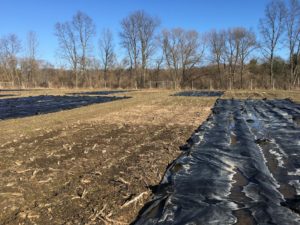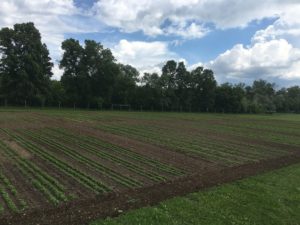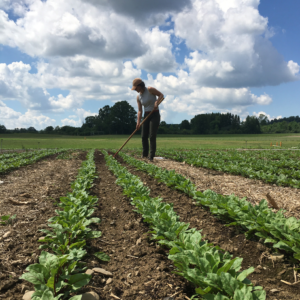Reduced Tillage Project Uncovers Tarping Impacts for Organic Vegetable Farmers
One farmer shared with us in early summer: “If we didn’t have a tarp down before our mixed greens this spring, we would have been in big trouble with our CSA. In our untarped plantings, we lost the crop to weeds. We’re not going to do that again.”

Tarped and untarped beds are compared side-by-side for our Reduced Tillage project.
Ryan Maher / Cornell Small Farms Program
Tarps are becoming a versatile tool to get a handle on weeds on the small vegetable farm. Our recent farmer survey of close to 100 other “tarpers” in the Northeast echoes this farmer’s experience and other stories we have heard. Tarps are working for lots of things: killing sod and cover crops, holding beds “idle,” allowing for early spring field access, and reducing tillage. Despite these successes, there are still a lot of questions about what’s happening under tarps and how these impacts add up over time.
Over the last six years, our Reduced Tillage project has used an ongoing, long-term permanent bed research trial to answer questions about tarping to help us reduce tillage in organic vegetables. We manage a sequence of crops over multiple years and roll out different tarping and tillage practices side-by-side. It turns into a complicated management matrix, where we compare tilled tarped plots to no-till tarped, and all of it to untarped ground. Some tillage is deep, intensive, and makes a clean slate and some is as shallow as we can go — then we ask if tarps can take care of the rest. Tarps are just plastic, not a source of organic matter, so we’re also looking at what happens when combined with compost and mulch. Along the way, we’ve been partnering with the University of Maine to have parallel trials and the experiment continues to move forward with support from NE SARE.

This year we planted beets in the long-term permanent bed trial.
Ryan Maher / Cornell Small Farms Program
Our crop changes from year to year, but the overarching questions remain the same. What are the changes in our soils, weeds, labor and crop yields? It still feels like we have only scratched the surface and, importantly, we are inheriting the consequences of all our management to see how it all changes over time. We are hopeful to get deeper with some questions, mainly about our soils, in the future.
This summer we put a beet crop in our rotation for the first time. Before jumping in, we checked off several of the boxes we typically think about when trialing a new reduced tillage practice:
- Try transplanted crops first. We initiated the trial with cabbage where soil conditions for planting are more forgiving than when direct seeding beets.
- Start small. Adjacent tarping trials in previous years showed we could be as successful with no-till beets as with conventional tillage.
- Don’t go into a problem field. We are fortunate to have very few perennial weeds, and when they emerge we are vigilant.
- Consider the preceding crop or cover crop and think through the soil conditions needed for the next crop. We expected the broccoli stalks from last fall would be formidable, and we’d need to put in the extra effort to remove them prior to no-till.
There is always the unexpected but in research we can also absorb the failures and share those lessons too.
Data has piled up this summer and we pulled out a beautiful beet crop in early August. We also managed to donate most of the harvest, more than five tons, through local and regional outlets. The field is now seeded to an oat-pea cover crop, and we’ve been reflecting on some of our trial observations this year.
Last fall, broccoli came out and tarps went down for an overwinter application as we saw our window for a cover crop shrink away. Tarps provided some cover on otherwise bare ground, suppressing chickweed and other winter annual weeds, but also gave us some winter headaches. With little snow cover, we often returned to adjust sandbags and secure windblown tarps from draping the hedgerows. Tarping labor does add up and the logistics can be challenging and messy, but overwintered tarps can get us ready to plant with less tillage and fewer weeds. We’ve also found that overwintered tarps can leave a lot of available soil nitrogen for the next crop, which is likely a result of less leaching losses and slightly warmer temperatures that can lead to more soil biological activity.

Time spent hand hoeing is recorded to track labor hours for the Reduced Tillage project.
Ryan Maher / Cornell Small Farms Program
This spring, when tarps came off, we had weed-free planting conditions with no-tillage — this has been the biggest labor savings for tarping in no-till over the years. We then managed to get a good beet stand with our seeder in all kinds of soil conditions, despite a number of struggles: seeds grinding through rollers, countless rocks in our gravelling soils (in unmulched no-till soils they seem to be multiplying), and the persistence of tilled stalks from that broccoli crop. We counted all our weeds as they emerged and found common summer annuals, such as hairy galinsoga, pigweed, and lambsquarter. Results from last year’s spring lettuce crop showed that tarping for three weeks after shallow tillage reduced our weeds at harvest by about 80% when compared to untarped beds.
We have also learned to not rely on tarping alone to control weeds and we are always prepared to do some hand weeding. Labor was in shorter supply for us this year, strained by COVID-19. So as we add up our recorded labor hours, we’ll have yet another lens to view how tarping affects farm labor. Now we’re feeling grateful for the late August rain to get our cover crop going, but won’t forget the extremely dry and hot summer we all struggled through. It’s one of those unforeseen pieces, as there’s always something. What we do know is that both tarps and tillage can drive changes in soil moisture, which may help us tell part of the story behind our beet yields.
Learn more about our past and current research on the Reduced Tillage project page.

